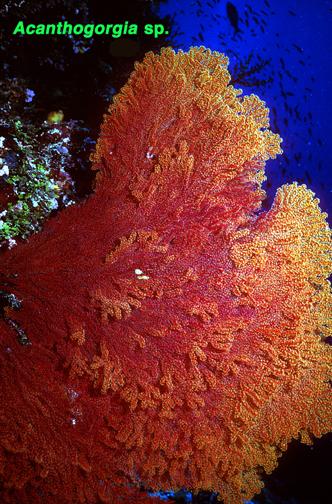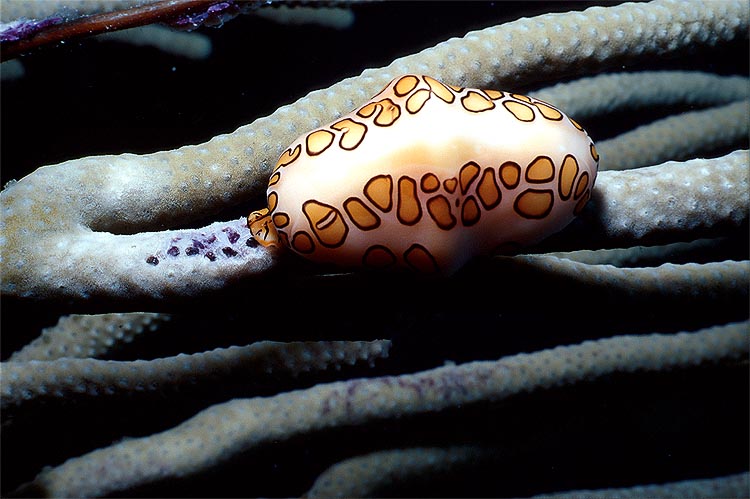The same way my dad reads non-fiction books, I turned to the pictures first. I was hoping for full-color photos and these are only black and white, but still, there are several undersea photos. Mainly they're of various underwater research vehicles and the occasional shark.
But there's one photo of a particular kind of coral that I've always thought was really cool-looking. So I'm going to find out what it is, and then I want to learn about what it does.

Sea Fan, from the Grand Cayman Islands. Fantastic, isn't it?
Photo from Florent's Guide to the Tropical Reefs, which has tons of great color photos of fishes and coral.
- This thing is commonly called a Sea Fan. You've probably seen them in fancy fish tanks, maybe at a Chinese or Japanese restaurant, or maybe you've seen them at your local aquarium or zoo.
- Sea fans are part of a larger family of coral called Gorgonians, which includes sea whips, sea plumes, and sea rods as well as sea fans. It's sort of confusing figuring out what's a sea fan and what's not. Apparently the family classifications have been changed a few times and not everybody is on the same page as far as what belongs in which group.
- For our purposes, I'll show you pictures of things that are for sure Gorgonians and that are probably also sea fans, as opposed to those other types of Gorgonians. Even those Gorgonians that are considered to be sea fans can have lots of different shapes.

Various types of Red Gorgonians, some with polyps extended.
(Photo from a German site about marine zoology, with lots of photos, called Senckenbergische Naturforschende Gesellschaft)
- All Gorgonians are types of soft corals, which means they don't calcify and fuse themselves together to become almost like rock, but instead they anchor themselves in thick beds of sand or mud, and they have a flexible, bendy skeleton made of a specific type of protein called gorgonin. This protein is very similar to the collagen in our tendons, except it is twice as strong.
- To me, the fact that may be the strangest about these things is something that's true of all coral: they're not plants, they're animals.
- But what's confusing is that some sea fans are photosynthetic (require light to process their food) and some are non-photosynthetic. But only plants are photosynthetic, you say, so how can sea fans be animals and also be photosynthetic? Very good question.
- The reason some sea fans are photosynthetic is they have tiny little planties that live among them, called zooxanthellae. Those zooxanthellae are actually very tiny, single-celled algae. The Gorgonians provide the algae with a place to live that's close to the sunlight and and their waste matter also provides food for the algae. In exchange, the algae produce oxygen and nutrients that are essential for the Gorgonians to be able to grow and reproduce.

Close-up of a coral's polyps showing zooxanthellae. On this particular coral, they're the reddish-brown stuff that looks sort of like rust.
(Photo was originally from a Biology course page at U Michigan, but which has since been taken down. Sourced from Estrella Mountain Community College page on stem eukaryotes)
- So if you've got a photosynthetic Gorgonian, that means it needs the little algae planties on it to survive, which means you've got to give your Gorgonian sunlight. If you've got a non-photosynthetic Gorgonian, you have to make sure it can get its necessary food and nutrients for itself. People who have aquariums say the non-photosynthetic varieties are harder to keep alive. Most Gorgonians are non-photosynthetic and prefer shadier, deeper waters.

The Purple Frilly Gorgonian is a photosynthetic gorgonian and favorite with people who keep home aquariums.
(Photo from Quality Marine)
- By the way, most types of coral have a symbiotic relationship with the zooxanthellae. In fact, in most cases, it's the tiny algae growing all over the various types of coral that gives it its bright colors.
- Whether they are photosynthetic or not (rely on mini-algae or not), they all have polyps that are fringed with tentacles. The polyps are crucial to the way the sea fans eat and grow.

Yellow Finger gorgonian with polyps closed.
(Photo from Live Aquaria, where you can purchase a Yellow Finger for $29.99)

Yellow finger gorgonian, with polyps extended.
(Posted by Nano at saltwaterfish.com)

Close-up of a red gorgonian and its multitudinous polyps.
(Posted by Nano at saltwaterfish.com)
- At night, the sea fans extend their polyps, which have stinging tentacles on the ends of them. Any food (plankton, mostly) that floats close enough gets trapped or stung and paralyzed by the tentacles. The food is then passed to the center of the polyp, which is kind of like a mouth.
- This video shows a few different types of sea fans. There's no sound, and the first few sea fans aren't doing much, just waving slightly in the current. But then it zooms in on one that has its tentacles extended, and you can see them close around food like a fist. It is totally cool.

Viminella, another type of Gorgonian.
(Photo from the German site Senckenbergische Naturforschende Gesellschaft)
- Though they do have stingers, sea fans rely mainly on the current to bring plankton and other food particles to them. So if you have an aquarium and you want to raise sea fans, make sure your aquarium has a good current to swish the food around.

A Gorgonian called Acanthogorgia.
(Photo from the California Academy of Sciences Invertebrate Zoology & Geology)
- Sea fans also rely on the current to help them reproduce. They make their sea fan offspring in one of two ways:
- Asexually -- a hunk of branch from the sea fan will break off, float around, and eventually land somewhere. Sometimes it lands in a favorable spot, takes root, and begins to form a new colony.
- Sexually -- most sea fan colonies are separated by sex; that is, the male sea fans are over there, and the female sea fans are over here. So the question is, how to get the eggs and the sperm together. Sometimes both male and female sea fans will spawn simultaneously, throwing their goods up into the water and hoping their stuff happily collides (my favorite version of coral reproduction). But more often the female sea fans will snag some floating male sea fan sperm and take care of the fertilized eggs in-house, so to speak.
- Regardless of how the sea fan eggs and sperm get together, the larva, which is like a mini-branch of the coral, floats around for a while. At first it will stay near the surface of the water and if it doesn't get eaten by some predator, eventually it will sink back to the ocean floor until it finds a sandy or muddy spot it likes and digs in.
- Predators of the sea fans include flamingo-tongue snails and white frilly sea slugs. I am not making this up.

A flamingo tongue snail eating a sea rod. The shell of the snail is actually a plain whitish peach color. The spots you see are a living tissue that the snail pulls over itself and that works like gills, helping the snail to breathe underwater. If you collected this snail and took it out of the water, the spotted tissue would retract and it would look like a boring old shell. Don't ask me why this snail is called flamingo tongue. That's a whole other Apple.
(Photo from Reef News)
Not to be a downer or anything, but scientists predict that unless people stop messing with the reefs and producing way too many carbon emissions, 40% of the coral reefs will be gone forever in the next three years. But it's not all doom and gloom because it's not too late to stop damaging the reefs and start protecting them.
By the way, I wrote an entry a while back about coral reefs in general. It's much less specific than this entry, and the types of coral described are hard corals rather than soft like the sea fans. But if you liked this entry, you might also like that one.
Sources
Wet Web Media, The Conscientious Marine Aquarist, Sea Fans for Marine Aquaria, the Gorgonians
Florent's Guide to the Tropical Reefs
World Database of Marine Species, Universita della Politecnica delle Marche, Sea fans, gorgonians. This site has photos of all types of Gorgonians, with polyps extended and without. A great resource.
Robert Toonen, Invertebrate Non-Column: Gorgonians, Advanced Aquarist's Online Magazine
Julian Sprung, Aquarium Invertebrates: Caribbean Gorgonians, Advanced Aquarist's Online Magazine
University of the Virgin Islands, Zooxanthellae
Coral Reef Alliance, Reef Awareness
Jane Lilley, Dead Men's Fingers and Other Soft Corals, British Marine Life Study Society
No comments:
Post a Comment
If you're a spammer, there's no point posting a comment. It will automatically get filtered out or deleted. Comments from real people, however, are always very welcome!